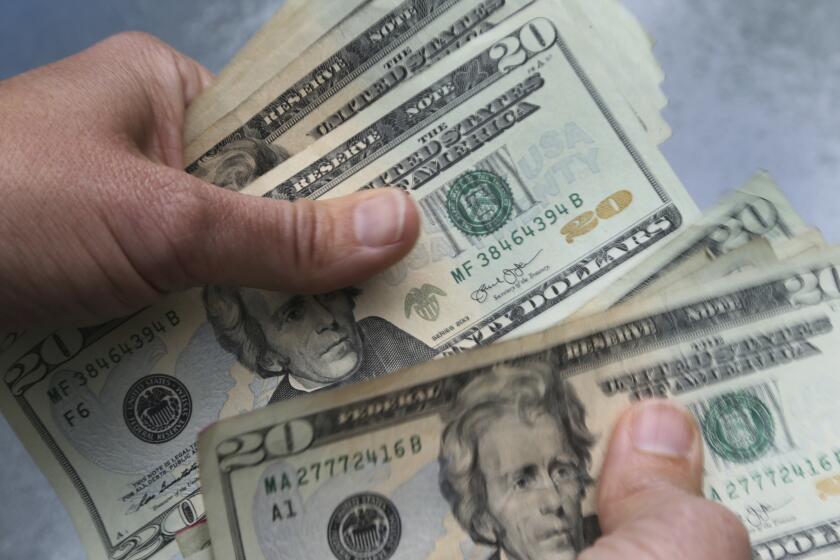It’s time to escape to California’s Gold Rush towns for postcard charms and swimming holes
- Share via
- Nevada City and Grass Valley, siblings in Gold Country near Sacramento, have been drawing more visitors than ever.
- Both towns preserve their mining heritage and are surrounded by the scenic South Yuba River.
You could argue that Nevada City peaked 170 years ago, along with Charles Darwin, Herman Melville and Queen Victoria.
But we’re still talking about them all. And Nevada City, 60 miles northeast of Sacramento in the Sierra foothills, is reachable without a séance.
In the 1850s, it grew from a miners’ outpost into a Gold Rush boomtown of 10,000 (heavy on the bars and brothels) before anyone got around to naming that other Nevada as a territory or a state. Today it lives on as a tiny town with a lively arts scene and a liberal bent, home to about 3,200 souls.
Perhaps because there’s so much to escape from these days, Nevada City and its larger, more middle-of-the-road neighbor Grass Valley have been drawing more visitors than ever lately. Nevada County’s hotel and vacation rental tax revenues have doubled in the last five years to a record high.
Planning your weekend?
Stay up to date on the best things to do, see and eat in L.A.
“A lot of people are coming up from the Bay Area and settling up here because Nevada City is in a lot of ways like the Bay Area,” said Ross Woodbury, owner of Nevada City’s Mystic Theater. “It’s a very blue town in a very red region.”
If you’re from elsewhere, it’s easy at first to overlook the differences among these Gold Rush towns. Once your feet are on the ground, however, the distinctions and fascinating details shine through — as do historic rivalries.
“Nevada City thinks it’s a little better than Grass Valley and Grass Valley think it’s a little better than Nevada City. I don’t think that’s ever going to change,” said restaurateur John Gemignani, standing by the grill of the Willo steakhouse in Nevada City.
“That’s never going to change,” confirmed his wife, Chris Gemignani.
Nevada City’s intimate size, upscale shops and throwback 19th century architecture alone are enough to win over many people. Its downtown is a 16-acre collection of more than 90 historic buildings, cheek by Victorian jowl. Say you have breakfast at Communal Cafe, lunch at Three Forks Bakery, dinner at Friar Tuck’s, a drink after at the Golden Era. You haven’t even hit 1,000 steps for the day yet, unless you’ve been dancing to the live music that often fills the area. (One night, I stepped from Spring Street into Miners Foundry — an 1856 landmark now used as a cultural center — and found about 200 locals gathered for a community sing, a chorus of Beatles-belting Boomers.)
For those who seek higher step counts, forested foothills and miles of trails wait outside town, along with often-perilous springtime whitewater and summer swimming holes along the South Yuba River. And in surrounding hill country, the Empire Mine and Malakoff Diggins, once the major employers (and polluters) of the region, now serve as state historic parks. The Beat Generation poet Gary Snyder (95 years old and well represented on the shelves at Harmony Books on Main Street) still lives on a ridge outside town.
Meanwhile, four miles down the road from Nevada City in Grass Valley, changes are afoot. The Holbrooke Hotel (statelier sibling to Nevada’s City’s National Exchange Hotel) reopened after a dramatic renovation in 2020. Soon after, spurred by the pandemic, the city closed busy Mill Street to cars, making it a permanent two-block pedestrian promenade full of restaurants, bars and shops.
About This Guide
Our journalists independently visited every spot recommended in this guide. We do not accept free meals or experiences. What should we check out next? Send ideas to guides@latimes.com.
Still, if Los Angeles moves at 100 miles per hour, Foggy Mountain Music store clerk Pete Tavera told me, “Grass Valley is like 60.”
Both towns preserve their mining heritage, and when you stroll through them, you can just about hear echoes of those raucous Gold Rush days. Here’s a little more of what I learned during a three-day visit:
- In the early days of the Gold Rush, most of the area’s mine workers lived in Grass Valley while the owners, bosses and other white-collar people built their upscale Victorian homes in Nevada City, the county seat.
- The Great Depression of the 1930s never really reached this corner of Gold Country, because the big hard-rock mines kept on producing gold.
- In 2024, when a company tried to restart gold mining at the nearby old Idaho-Maryland Mine, residents of Nevada County, which includes Nevada City and Grass Valley, rose up and the county board of supervisors shut down the idea, citing environmental risks. These days, it seems, Nevada County wants to remember gold mining, not live with it.
Because everybody needs a break now and then, here is a closer look at 15 essential spots, starting in Nevada City, continuing with Grass Valley.
Be charmed by the Gold Rush-era buildings on Broad Street

On your way up the hill, you’ll encounter City Hall, Brothers Art & Antiques and the Golden Era Cocktail Bar, alongside assorted restaurants, boutiques, chocolatiers, hatters and acupuncturists.
Farther up the hill stand the Nevada Theater, Firehouse #2 and the old Methodist Church, all dating to the 1860s. Just beyond that, the old homes and lodgings begin, including the Broad Street Inn, a pleasant, cleverly updated 1870 building where I stayed in an upstairs room for $140 nightly.
Cross a suspension bridge on the Deer Creek Tribute Trail
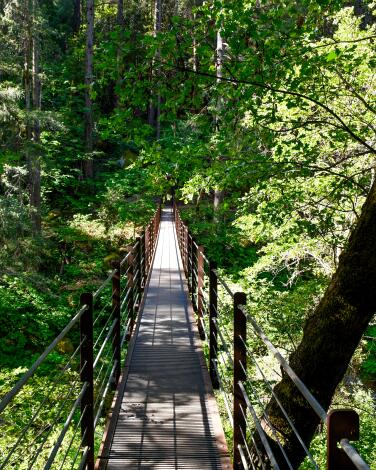
Whether you choose a short or long route, you’ll soon be stepping under a tall canopy of trees and dipping down alongside Deer Creek, which runs right past downtown Nevada City, carving granite boulders as it goes.
I began in town, following Old Downieville Highway, crossed the Angkula Seo Suspension Bridge (with its thrilling little wobble as you step over the creek), then returned to town by way of Jordan Street. That was a 2.2-mile loop, made slightly longer because I nosed around the creek and boulders.
I also lingered on the suspension bridge, which is part of the “tribute” element of this trail. It’s designed to honor the Nisenan people (who lived here for generations before immigrants from Europe appeared). Another bridge to the west honors Chinese immigrants (who played a key role despite being targeted by racism in Nevada City and other Sierra towns).
There’s a bonus if you’re doing any of this with children: Local authors Douglas P. Bratt and Laura Bowman have written a chidren’s book, “The Amazing Fezziwig” (about a golden retriever’s Nevada City travels), and placed nine miniature Victorian “Fezz houses” around town and along the trail. They look like psychedelic birdhouses. Even if you never lay hands on the books, you’ll be pleased every time you spot of those little houses.
See the town’s most photographed building on Main Street
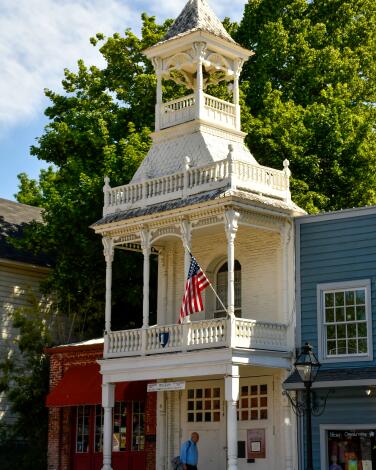
In Robinson Plaza, two enormous metal pieces of old mining equipment are on display, looming over the scene like a pair of austere contemporary sculptures. I’m not sure Richard Serra could have done better.
Within a few strides, you reach Harmony Books (and its ample inventory of works by Gary Snyder). Back in 1859, the occupant of that brick structure was a man named James J. Ott — perhaps the most important man in town, since he was the assayer who measured the value of ore from local mines.
Next to the bookshop is the Chamber of Commerce office. Across Coyote Street, you find Treats (ice cream) and perhaps the town’s most photographed building: the bright white Firehouse No. 1 Museum, which looks like it should be placed on a Victorian wedding cake. The firehouse operated from 1861 to 1938. Now, outfitted with a balcony and bell tower, it’s run by the Nevada County Historical Society.
Stay in a themed room at the delightful Outside Inn

The owners, who arrived in 2022, have also added another unique feature: vegetable baskets where guests and neighbors can share produce.
The motel, notably tidy and surrounded by pines, stands in a residential neighborhood two blocks from downtown. Rates generally run $125-$265, and there’s a two-night minimum on weekends.
Find swimming holes and trails at Edwards Crossing, South Yuba River

It and the nearby parking area give you access to riverside hiking and the water itself. Just be careful.
The South Yuba is a cold, fast and dangerous river in spring and early summer, but by late summer it slows and warms, offering several popular swimming spots. (The ’49er Crossing, a.k.a. 49 Crossing, a.k.a. 49 Bridge, is another popular riverside spot.)
The Spring Creek Trail begins on the north end of the bridge and runs downstream for about a mile. A portion of the longer South Yuba Trail runs for five miles between Edwards Crossing (to the east) and Purdon Crossing in the west.
And then there’s the bridge itself, which dates to 1904. It’s a one-lane, steel truss bridge, graceful and sturdy enough for cars. But authorities say it’s too weak to hold a 20,000-pound fire truck. (And fire trucks typically weigh that much or more.) A new and stronger bridge is due to be built next to the existing one (which would stay in place to serve hikers and cyclists), but the timeline is uncertain.
Back in the day, this bridge along North Bloomfield Road was a busy route to the Malakoff Diggins mine. Nowadays it still leads to that now-idle mine and the ghost town of North Bloomfield, which are preserved as parts of Malakoff Diggins State Historic Park. The park’s website notes that if you have a high-clearance vehicle and “and spare time,” the old route still works. But travelers can get to that park faster by way of Highway 49 and Tyler Foote Road.
Stock up on Asian snacks at Winnie Superette

In the early Gold Rush decades, this stretch of Commercial Street was home to Nevada City’s Chinese Quarter, offering goods and services to hundreds of Chinese immigrants. But many white people resented those immigrants, and after a fire destroyed the Chinese Quarter in 1880, Nevada City’s leaders tried in vain to ban Chinese people from the city.
All these years later, Winnie Superette owner Anne Han (who came to town from Los Angeles) stocks a pan-Asian inventory that includes condiments, rice, ramen, seaweed sheets, Hello Kitty snacks — and art. Landing a spot in the old Chinese Quarter seemed like “kismet,” Han said.
For most of June, Winnie Superette’s featured art show was “Ghosts of Commercial Street: A Fever Dream of the Chinese Legacy in Nevada City,” a series of paintings by Joie King, a Chinese American artist who lives in Nevada County.
Though Han estimates the town’s Asian American population at “less than 10,” she said she was confident that plenty of locals and visitors would be attracted to her goods.
So far, so good: The superette was recently named “new business of the year” by the Nevada City Chamber of Commerce.
Enjoy nightlife on Commercial Street, which lights up at dusk

Then there’s the Mystic Theater (240 Commercial St., no website), a 30-seat, suggested-donation venue whose owner-manager, Ross Woodbury, offers an eclectic array of “foreign films, documentaries, classics — the kind of things you can’t see at the usual cineplex.” The atmosphere is like “a friend’s library or den,” he described.
Find your seat at Nevada Theatre, one of the few remaining buildings where Mark Twain spoke
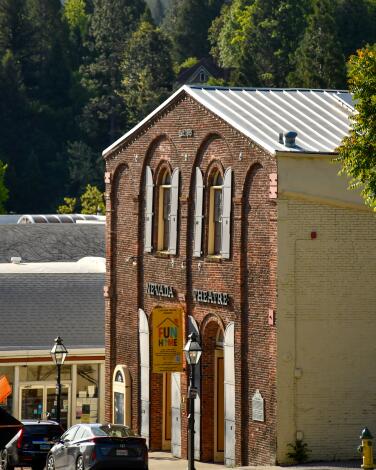
He killed, as they say, and the author realized that talking about trips could be at least as remunerative as writing about them. The following year, he sailed on the epic cruise to Europe and the Holy Land that is described in his book “The Innocents Abroad.”
These days, the Nevada Theatre‘s schedule includes musicals from the local Lyric Rose Theatre Company, a touring stage production of “Dr. Strangelove” and a series of Sunday night movies, including “The Blues Brothers” and “Paris, Texas.” Mark Twain, John Belushi and Harry Dean Stanton, together at last, sort of.
Watch your New York steak sizzle at the Willo

Indoors, there’s a bar side and a dining side, and in the dining room, steak is the clear favorite. While choosing, you can read the joint’s history. First it was Bill Davis’ Hut, then Wilma’s Hut, then Tuck’s Hut. Over time, as the menu grew to include burgers and then steaks, the building grew too.
Alas, since some county officials put their foot down a while ago, you can no longer grill your own dinner. But you can watch your steak sizzle. The current owners, longtime locals John and Christina Gemignani, say they have changed as little as possible since taking over last year.
All meals ($20-$48) come with a scoop of ice cream for dessert. It’s open Thursdays through Mondays, dinner only.
As for the name Willo? It comes from a couple of former owners — part of Frank Williams’ last name and part of his wife, Lola’s, first name.
Step into the dramatically restored National Exchange Hotel

The National has 38 guest rooms, a bar and a restaurant named for Lola Montez, an actress and dancer of the Gold Rush era. Some rooms radiate 19th century vibes; others hint at the 1920s. The front desk has moved from upstairs to street level. The third-floor balcony has vanished, but a few rooms open to the enduring second-floor balcony, which looks down on the heart of Broad Street.
Like the stately old Holbrooke Hotel in Grass Valley, the hotel was purchased in 2018 by Santa Barbara-based Acme Hospitality, which then invested millions in restoring and relaunching both properties. (Acme’s founder, restaurateur and entrepreneur Sherry Villanueva, was a key player in the emergence of Santa Barbara’s Funk Zone.)
Summer rates get as low as $165 on weekday nights and typically double on weekends. Bear in mind that there’s no pool and guest rooms don’t have TVs.
Also, for what it’s worth, a plaque outside claims that the hotel was site of “the first whipping post in state.”
Jam to folk music under the pines at Nevada County Fairgrounds
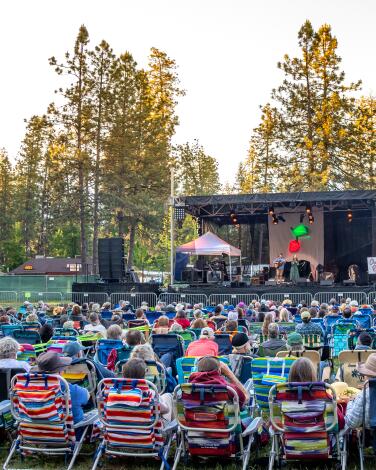
For more than a decade that venue has hosted the Strawberry Music Festival, “a family-friendly campout with live music” that goes back to 1982. The festival has grown to fill six days each May and five more days in October, and those days and nights are known for their abundant jam sessions on the 100-acre fairgrounds nestled among pine trees.
The same venue hosts the three-day KVMR Celtic Festival, a spring celebration of music, dance and culture that goes back to the 1990s. In June, there’s a four-day Father’s Day Bluegrass Festival, and in August, there’s the five-day Nevada County Fair.
Enter the stately Holbrooke Hotel (and its saloon and speakeasy)

Then came assorted fires and reconstructions as the Gold Rush progressed and the town grew. Since 1862, the hotel has been a two-story, 17-room mainstay of Grass Valley. In 2020, it reopened after an 18-month restoration/renovation.
You’ll still find the saloon just right of the well-appointed lobby. The Iron Door speakeasy is downstairs, the Gather & Mill gift shop and housewares shop on the ground floor. The hotel also has a sort of annex: The Purcell Carriage House, just across the parking lot, has 11 more rooms, priced 15-20% lower.
Even if you don’t belly up to the Golden Gate’s marble bartop for a drink, stroll through and consider that a young Mark Twain probably drank here: He definitely delivered a lecture in Grass Valley in 1866 (then went on to Nevada City).
Summer rates in the hotel proper start about $200 on weeknights, $360 on weekends. (In the hotel proper and carriage house, guest rooms have no TVs. Some have clawfoot bathtubs; some have step-in showers.)
Stroll slowly through Main Street, Grass Valley

Foggy Mountain Music, founded in 1975, operates in a 19th century building on West Main crowded full of instruments. (If Los Angeles moves at 100 miles per hour, clerk Pete Tavera told me, “Grass Valley is like 60.”)
One of the newer restaurants — with bold colors, a lively, young clientele and turntables in the corner — is Bicycle Thief, a pizza place on East Main that opened in 2024. (It serves dinner Wednesday through Sunday and lunch on weekends.)
Discover trails and gold-mining history at the end of the Bridgeport Covered Bridge

If you’re in a hurry, just walk across (or should I say through?) the bridge. It dates to 1862, is 216 feet long and has little windows looking out at the forest and rushing water. It was closed for restoration for 10 years until reopening in 2021.
If you have more time, head for the Buttermilk Bend Trail, which measures 2.4 miles out and back. Besides great views as the river bends and straightens, the trail offers a chance to see spring wildflowers or, if it’s summertime and the water is calm, slip down to water’s edge for a dip.
See a blacksmith at work at Empire Mine State Historic Park

The Empire Mine pulled gold from the earth from 1850 to 1956, then sat idle for years before the state opened it as a park in 1975. It’s better suited to park usage than you might expect, because the owners built a mansion, clubhouse and gardens on site and there are 14 miles of trails, along with shaded picnic tables outside the entrance.
Still, many visitors head straight for the buildings and tools that did the hard work of extracting more than 5.8 million ounces of gold through 367 miles of mine shafts, now shut and mostly flooded.
On the day I visited, volunteer Russ Osman-Bravard, a retired teacher, was demonstrating blacksmithing.
“Beat, heat and repeat — that’s the recipe,” Osman-Bravard said, bending a length of metal that would become a dinner-bell triangle for sale in the gift shop.
Besides building immense wealth and fueling the local economy, this enterprise caused deep environmental damage and presented various dangers to workers. Twenty-six died over the years. (The mine’s old cyanide plant, where the chemical was used to extract gold from ore, is off limits.)
Exhibits indoors tell how many miners were recruited from the area around Cornwall in England. There’s further evidence of this in town, where two different Grass Valley shops — Grass Valley Pasty Co. and Marshall’s Pasties — still specialize in Cornish pasties.
Wine, books and antiques await on Grass Valley's car-free Mill Street

For a two-block stretch near Main Street, Mill Street’s shops, restaurants and bars take advantage of patio dining and pedestrian-friendly lighting, seating and landscaping. Some locals lament the lost parking spots, but the ban on cars, begun during the pandemic, remains in place.
“It’s lovely,” said Mary Holland, waiting tables at the Owl Tavern. “It has changed the vibe of the place so much. Yoga in the mornings. People do live music.”
You can sip at the Cork 49 wine bars; browse the Artworks Gallery Co-Op; or thumb through old postcards at the Antique Emporium. Then there’s Gary’s Place, a historic bar and restaurant that goes back to the 19th century days when its only customers were men and “working women.”
Inside, there’s a pool table in back and a tiled channel (idle now) that runs at foot level along the base of the bar.
“Yes, that was a spittoon and it had running water up until the 1980s, I think,” said owner Kim Spinella.
Before you leave the neighborhood, here’s a bonus for the bookish: On Mill Street, you have the Book Seller for new books. And two blocks east on Bank Street, you enter the world of Booktown Books. This is a co-op of eight booksellers whose inventory includes used and rare books, ephemera, vinyl, CDs, art and vintage board games.




